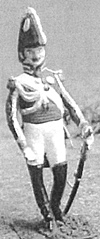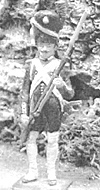 Waterloo was the origin of metal miniature wargaming for many of us in the hobby. We were captivated by the drama of Wellingtonís thin red line of English troops, daring to stand against the irresistible assault columns of Napoleonís Old Guard Grenadiers in their towering bearskin hats. The red flashes from muskets and cannon spat death and dense clouds of smoke. Then, up out of the gray smoke rose the glistening bayonets of the French. Waterloo was the ultimate confrontation, and the first pair of regiments I bought from Jack Scruby and painted were a regiment of British infantry firing (first rank kneeling, second rank standing), and a regiment of French Old Guard Grenadiers advancing with the bayonet.
Waterloo was the origin of metal miniature wargaming for many of us in the hobby. We were captivated by the drama of Wellingtonís thin red line of English troops, daring to stand against the irresistible assault columns of Napoleonís Old Guard Grenadiers in their towering bearskin hats. The red flashes from muskets and cannon spat death and dense clouds of smoke. Then, up out of the gray smoke rose the glistening bayonets of the French. Waterloo was the ultimate confrontation, and the first pair of regiments I bought from Jack Scruby and painted were a regiment of British infantry firing (first rank kneeling, second rank standing), and a regiment of French Old Guard Grenadiers advancing with the bayonet.
Fought with metal miniatures, the Napoleonic Wars offer the pageantry of history. Armies colorful enough to make a peacock blush marched and fought all over Europe for a quarter century. The French climbed over the Alps, trudged through the sands of Egypt past the Pyramids, and limped back through the ice and snow of a Russian winter in rags. The fate of nations was decided at gunpoint. The Battle of Waterloo dashed republicanism and nationalism, and put the monarchs of Europe back in the proverbial saddle for the next hundred years.
Napoleonic Warfare was the old game of Paper, Rocks, and Scissors converted to Column, Line, and Square. If an infantry regiment wanted to move fast and hit the enemy hard, they fix bayonets and formed column (something like a marching band with an attitude). If they wanted to shoot their enemies from a distance, they formed a two rank line, so that everyone could blaze away at the enemy. If enemy cavalry threatened to ride you down and saber you to death, the infantry formed square, presenting nothing by a bristling line of bayonets and blazing muskets in all four directions. Of course, if you form a square and the enemy forms a line, only ľ of your troops can fire, while all of his can fire. (Do the math.) Of course, if you stayed in line and the enemy hits you with cavalry, you wonít have to worry about saving for your retirement. The beauty of the Napoleonic Wars was that the infantry, cavalry and artillery are all on an equal footing. Each could win the battle. All three are necessary. The key to victory lay in using each element of your army to its optimum advantage in combination. Leading your tiny troops into battle means making decisions. Making the right decision leads to victory, while using your troops improperly leads to meeting your own Waterloo.
 Historical wargaming requires some knowledge of the history of the period in order to fully appreciate what is happening. As an historian, I find that to be no problem. Even my friend Richard, who is an engineer, manages literacy quite well, so I assume itís a possibility for everyone. Of course itís still possible to play without any background knowledge. I just donít think itís as much fun.
Historical wargaming requires some knowledge of the history of the period in order to fully appreciate what is happening. As an historian, I find that to be no problem. Even my friend Richard, who is an engineer, manages literacy quite well, so I assume itís a possibility for everyone. Of course itís still possible to play without any background knowledge. I just donít think itís as much fun.
Itís one thing to wonder if the Prussians will arrive in time to save the English from defeat at Waterloo. Itís another thing to know that this depends upon the Prussian commander, Marshal Blucher, an octogenarian Swedish cavalryman who occasionally thought himself to be pregnant with an elephant. Ancient Blucher had led a dozen cavalry charges against the French Old Guard the day before, and was in a bad way after his horse died and fell on him. As he lay unconscious, his chief of staff, Gneisenau, who personally distrusted Wellington, had to make the decision as to which way to march with the army. The following day, tough old Blucheró-driven by his hatred of the Frenchó-led his troops to victory over Napoleon at Waterloo. Knowing the history makes it more interesting.
The hobby itself has grown beyond the wildest limits of the imagination of its founders. There are more gamers with more miniatures playing more rules systems at more clubs and conventions than ever. This hobby has seen no casualties, unless you mean the little metal lads, but they get to rise again like the Phoenix for each new battle. Ironically, this is one hobby that has not met its Waterloo.
Back to Novag's Gamer's Closet Fall 2002 Table of Contents
Back to Novag's Gamer's Closet List of Issues
Back to MagWeb Master Magazine List
© Copyright 2002 by Novag
This article appears in MagWeb.com (Magazine Web) on the Internet World Wide Web. Other articles from military history and related magazines are available at http://www.magweb.com